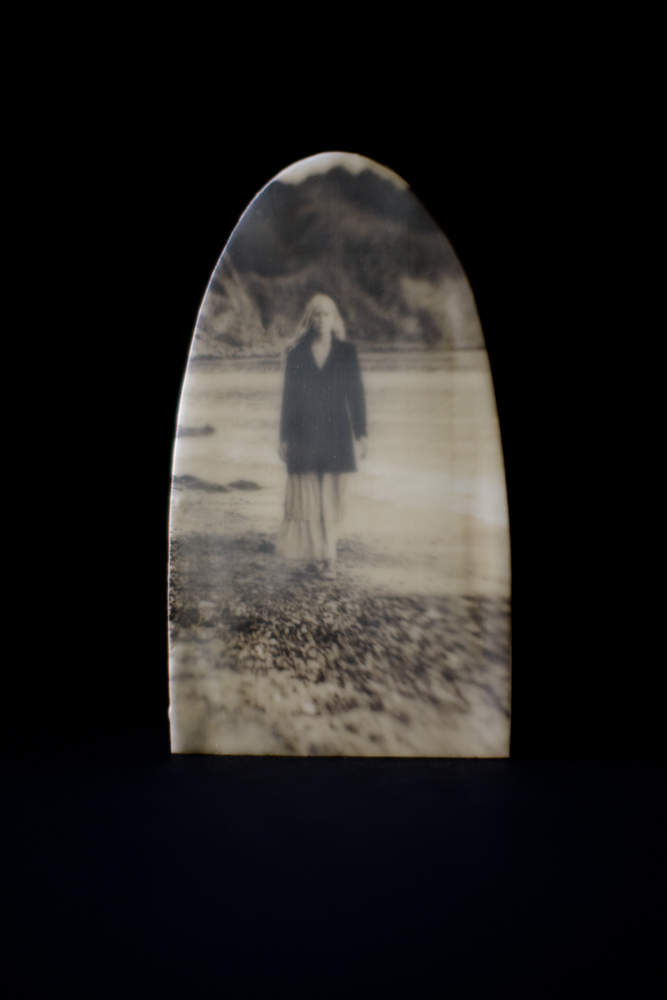Interdisciplinary Approaches in Photography: Anne Renée Silver
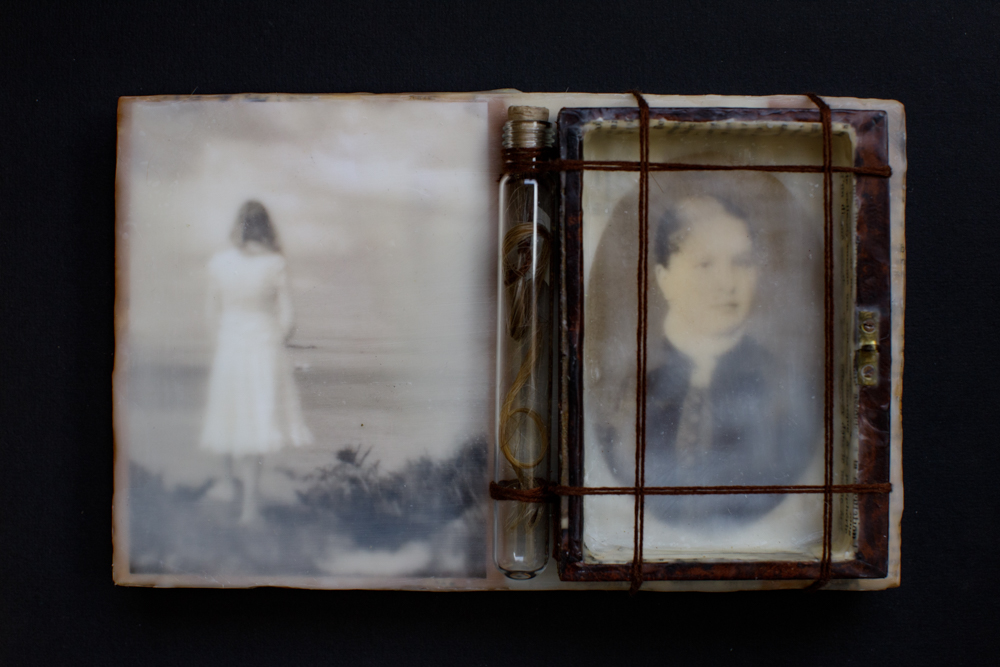
©Anne Renée Silver, Who We Were Is Who We Are: Encaustic mixed media. One found and one original photos, test tube, lock of hair, embroidery thread, found objects, found papers. Mounted on a wooden puzzle box lid. 6” x 9”
This week, all of the artists that I am featuring take photography beyond what it is or what it is perceived to be, to what it can be. There are a wide range of themes such as family, culture, loss, history, memories, biblical stories, mythology, film and community among others. For all of these artists, the photograph is the starting point, not the end result. Beyond photography, their approaches incorporate painting, stitching, alternative processes, object making, sculpture, installation and even community engagement. Each of them employ process and content that creates a uniquely personal style of photography that demonstrates extraordinary vision.
I met Anne Renée Silver in 2019 as a part of the Pigs Fly Retreat on Cumberland Island. Anne flew all the way from France to take part in this adventure. I was Immediately struck by her vulnerability and her willingness to be open, sharing work that was poignant and really intimate. These timeless images include themes of beauty, love, motherhood, memories, loss, healing, and redemption.
After hearing Anne’s story, the images resonated because they felt gut-wrenching, especially when she is being held up by two book ends or carrying around a basket of eggs, or even waving the white flag in these self-portraits. Anne’s current series, Thresholds, feels like a transition to acceptance and redemption. The images with the objects feel as if they create a time machine back to a memory that is impossible reach.
Anne Renée Silver is an American photo-based artist/writer who resides in France with her husband, Pierre, and her cat, Peluche. She studied at Southern Illinois University Carbondale, where she spent three years as a student in Plant Biology but changed courses in mid-stream and went on to receive both a bachelor’s and a master’s degree in Social Work. She worked for many years in private practice as a Licensed Clinical Social Worker who specialized in trauma and loss, anxiety and depression. Her intense connection to plant life, to gardening, and to the natural world is a recurring theme in her work. After moving to France in 2016, Anne dedicated herself full-time to making art. She has a fundamental need to create and a life-long love of learning. She is always pushing herself to find different and exciting ways of working with or presenting her images. Anne enjoys making handmade artist’s books, mixed-media pieces, photo encaustic pieces, hand- and machine-stitched pieces, cyanotypes, image transfers, and chlorophyll prints. Her work has been exhibited in various locations around the world, notably, in France, Portugal, India, and the US. Her images have been published in Diffusion X, SHOTS Magazine, and the Hand Magazine. She is the author of the self-published book, Pénombre, which is a journey inward, told in poetry and photos, exploring notions related to grief and healing. Anne’s work focuses on central themes of grief and loss, healing and resilience, intimacy and connection, memory and dream.
Follow Anne Silver on Instagram: @anne_silver_
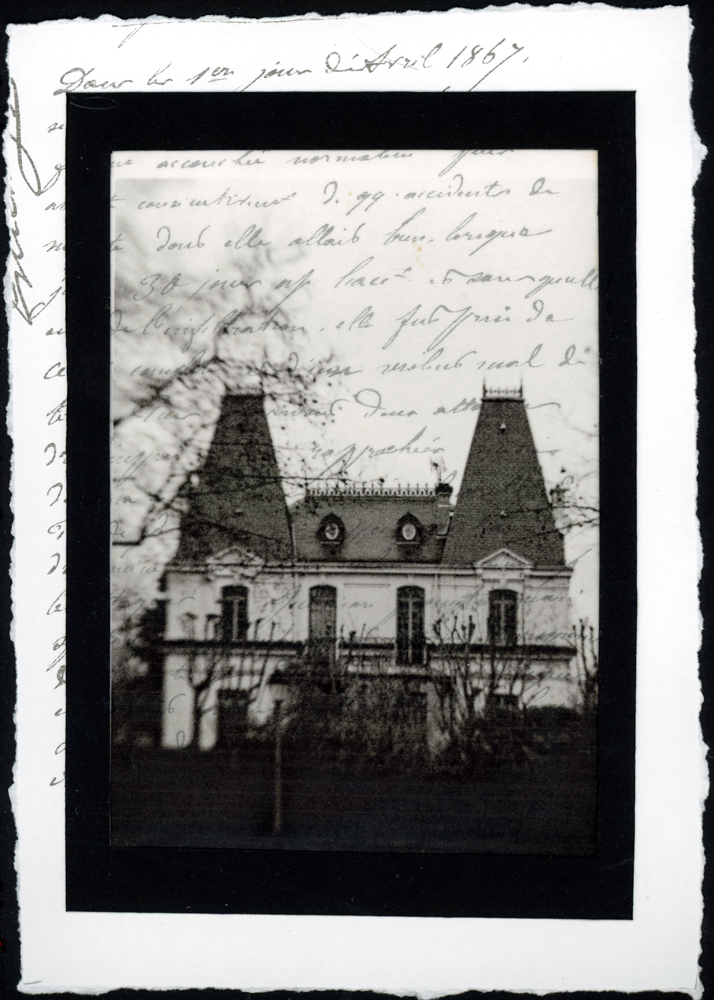
©Anne Renée Silver, La Maison Bourgeoise: A page from the Thresholds handmade artist’s book. Pigment print on vellum, laid over found text.
Thresholds
Minuscule, often unnoticed, points of passage, thresholds occupy space at crossroads of memory and dream. Every blink of an eye; every respiration; every experience moves us forward. We are constantly crossing over— if only from one moment into the next, standing on the bridge between what was and what will be. Our lives are marked by milestones, by rites of passage, by enormous losses. I’m continually amazed by what and how we are able to survive. Somehow, we keep going. Somehow, we learn to live with the unimaginable. We learn to accept, we adapt, we integrate it all, and we evolve. In short, we heal, becoming stronger in the broken places. We surrender, opening ourselves up, and when we’re lucky, a tiny bit of grace steps in.
“Thresholds” grew out of a traumatic surgery, and, as it is cumulative in nature, every new trauma awakens all of the older ones we have known. I began the project two years post-operation, at a time when I was starting to feel centered and hopeful again, despite on-going problems. The project is a meditation on courage, memory, healing, hope, and resilience. It explores where that resilience comes from and how I am able to tap into it. It is an affirmation of the Self and the connections that are most important to me. “Thresholds” is about bearing witness to my own life, noticing and honoring the beauty that flows around, in, and through me. Ultimately, it is about the fullness of what it means to be human. The work in “Thresholds” is photo-based, but I have also created a collection of handmade objects. Working in this way is something that deepens the process for me. Being a sensorialist, I have a fundamental need to create in the physical sense. It’s been in my bones since I was a little girl, and so making mixed-media objects, encaustic pieces, fabric pieces, and artist’s books is a way of coming full-circle, of connecting to the little girl I once was, of reclaiming my innocence. In the end, that’s what healing is all about– rediscovering, reconciling with, and reconnecting to ourselves despite everything we’ve been through.
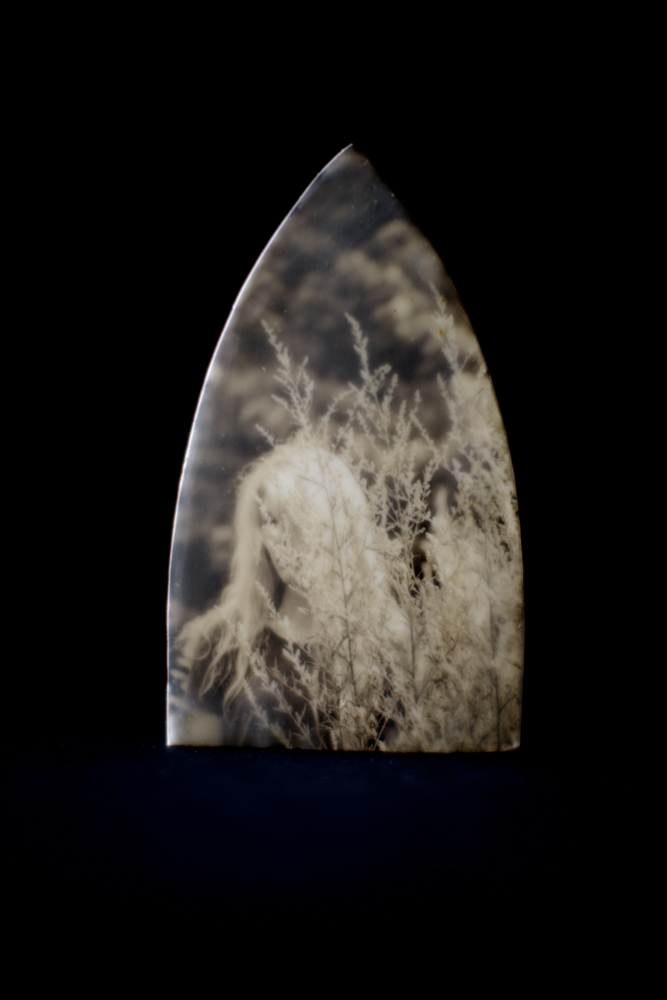
©Anne Renée Silver, In the Field Where the Wormwood Sleeps: Photo encaustic mounted on an old rusty iron. 4” x 8”
Greg Banks: Before moving to France, you worked as a Clinical Social Worker and you mentioned in your statement using artistic techniques with patients. How does teaching those approaches influence your own work?
Anne Renée Silver: I worked for 15 years as a mental health therapist, mostly helping adult women who were survivors of childhood sexual abuse. Because trauma is encoded in the parts of the brain that aren’t associated with language, we struggle even more to put words on experiences that so profoundly affect us. Even in ordinary circumstances, words alone can be insufficient in conveying the depth and breadth of what we are feeling. And so, I used collage- and mandala- making in my practice as therapeutic techniques to help my clients recognize and express their feelings, to facilitate healthy coping strategies, and to give them access to an alternative language when words failed. I’m not sure that teaching them has had an influence on my own work, as they were both things I was doing already in my artistic life before I had incorporated them into my therapist’s toolbox. Given that these techniques had helped me, I thought they could possibly be beneficial to others who were interested in exploring them.

©Anne Renée Silver, An Autumn Story: Hand- and machine-stitched fabric scroll book of 8 images. Made from vintage linen. 6” x 72”
GB: Your imagery is really personal. How do you determine how much to share? Or do you feel like making the work is therapeutic?
ARS: Making the work is definitely therapeutic. Determining how much to share is something I struggle with, however. Some days I am braver than others. It’s a delicate balance. The paradox for any artist lies in the need we have to be seen and understood and the intense vulnerability, and therefore, risk, that accompanies that need.
GB: The Threshold series feels more hopeful than your earlier work. What would you like to say about the earlier work and would you speak to how it led you to this series?
ARS: Thresholds flowed from the earlier work, notably my Pénombre and Elegy projects. All of my work is about memory, healing, resilience, and transformation. Healing doesn’t occur in a straight line. It spirals around. It ebbs and flows. As time creates distance from past traumas, the way we relate to them can change. This series
explores safety, hope, love, transcendence, wonder, and beauty. These are my raison d’être. These are my solid ground. I believe in the power of authentic beauty to save lives. It has certainly saved me— again and again. Beauty is a threshold, as it opens up to something that exists simultaneously inside of and outside of time. It stops us. We stand in reverence before it, unmoving, holding our breath. It’s moments like that that I try to capture with my camera.
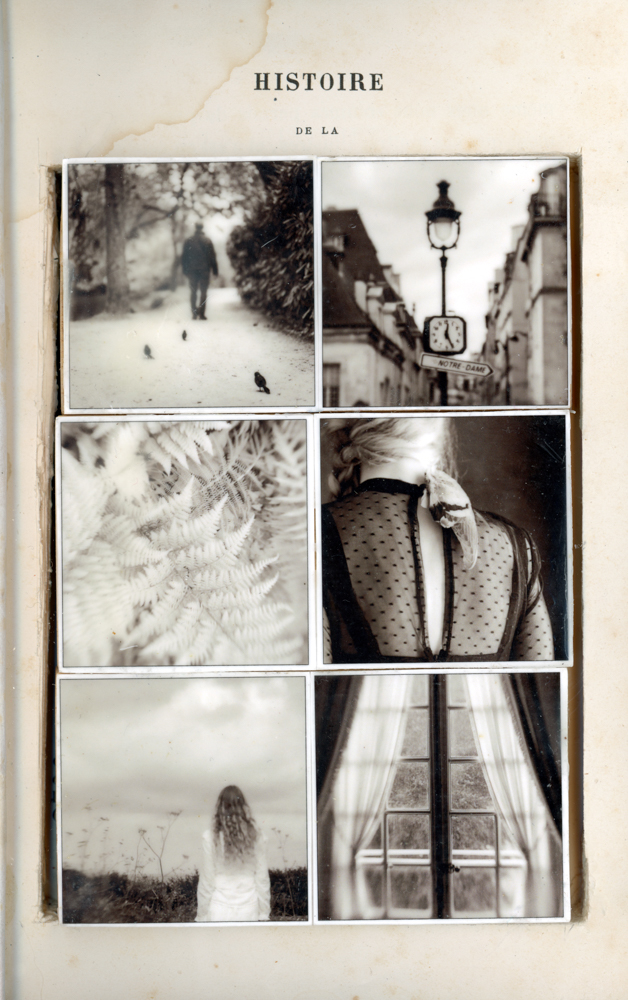
©Anne Renée Silver, Here and There, Then and Now: Mosaic of 2” square photo encaustics set into a carved-out, found book.
GB: Talk about what inspired this series.
ARS: Three years ago, I had an expanded hysterectomy. It was a long and difficult
procedure for the surgeons, as there were complications that arose both during and
after the operation. It was deeply traumatizing, one of the most difficult thresholds I
have ever crossed. Nothing has been the same since. As with any trauma, there is a
« before » and an « after. » The work is an affirmation of everything that has helped
me accept and integrate that experience. I struggle with on-going problems,
including endometriosis, adhesions, and nerve damage. The surgery wasn’t a
panacea or a sort of deliverance in my case, which is what the majority of women
experience. For me, some things are better; other things are worse. The body work
in Thresholds represents the process of learning to live with what we cannot change
and the serenity we find in surrender.
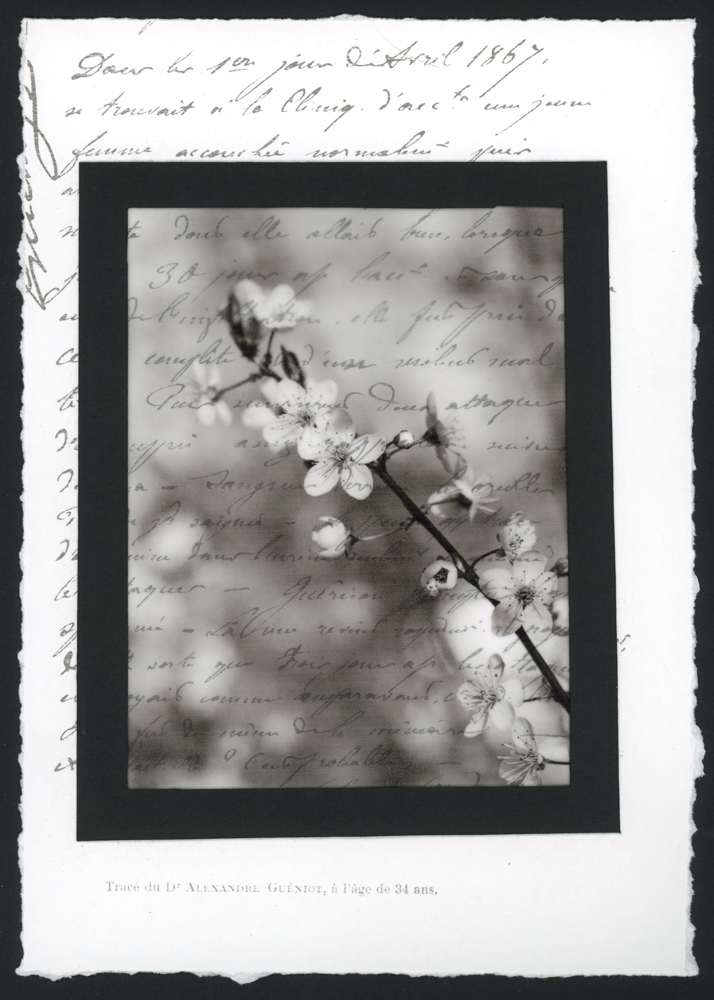
©Anne Renée Silver, Rebirth: A page from the Thresholds artist’s book. Pigment print on vellum, laid over found text.
GB: How does being in France inspire your images?
ARS: Everyday I express gratitude for living with the love of my life in this beautiful country. I have always had a deep affection for and connection to things with a past,
especially old houses and ancient trees. Both of those are plentiful where I live.
There are places here in France where history is palpable. Depending on where you
are, there are vestiges of prehistory, the Gallo-Roman era, the Middle Ages, the
Renaissance, the French Revolution, the Belle Époque, the first and second world
wars… History, and the shadow it sometimes casts, infuse everything here. I live in
the Valley of the Impressionists, and I can still feel their presence when I walk along
the river or follow the cobblestone impasses that wind through the village. The
connection to the past feels stronger here than it does in the US. The French have
such a rich, complex, long history. The US is relatively young, as countries go.
There’s also just a lot of cool old stuff here. I have acquired so many unusual things
from my husband’s parents’ estate, from thrift stores, from flea markets. Much of it
ends up finding a place in my work in one way or another.
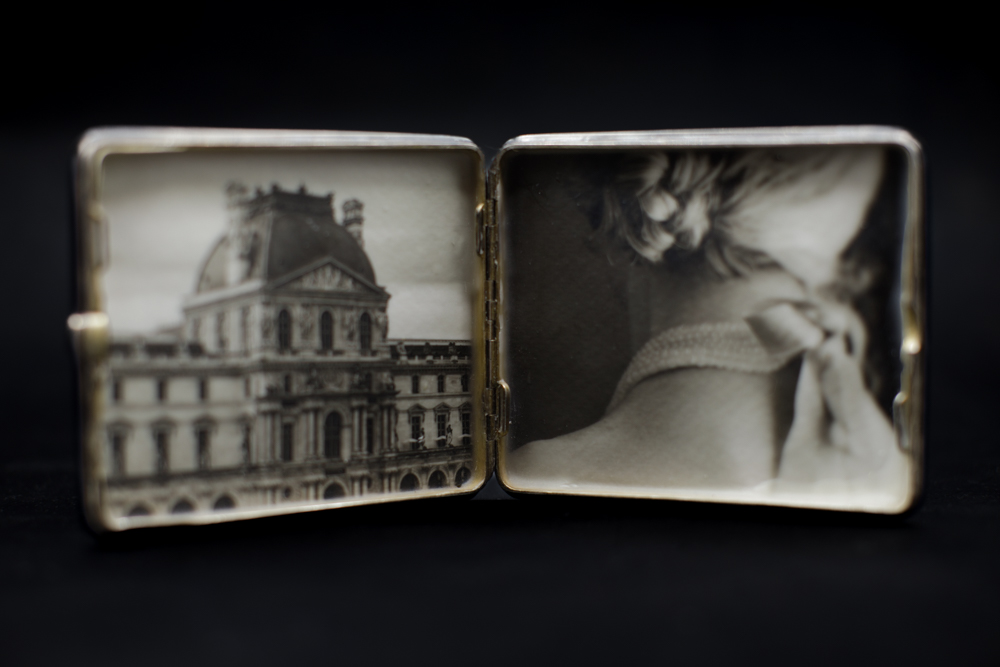
©Anne Renée Silver, Bejeweled: Photo encaustic diptych mounted inside a silver cigarette case. 7” x 4”
GB: Could you talk about your process? What encourages you to make an object as opposed to a traditional print?
ARS: All of my life, I have made stuff, from sewing to painting to drawing to
collage/assemblage. It’s a fundamental need of mine to have my hands in the
process. It’s a way of slowing down. It seems as if time stops while I am working. I
get lost in the flow for hours, and sometimes that’s only from staring at a piece and
laying different items on it, playing with the arrangement, waiting for it to tell me
exactly what and how it wants to be. I like the tactile quality of handmade pieces,
whether they are made from paper and prints, antique linen, or coated in encaustic
medium. Wax is a wonderful medium. Everything about it, from the way it smells, to
brushing it on a piece, to scraping it off, to smoothing it out is therapeutic. It’s like
skin, in a way. It can be marred, scraped, burned, pierced, and it can also be
“healed.” I like things that contain layers, things that are half-hidden, half-revealed.
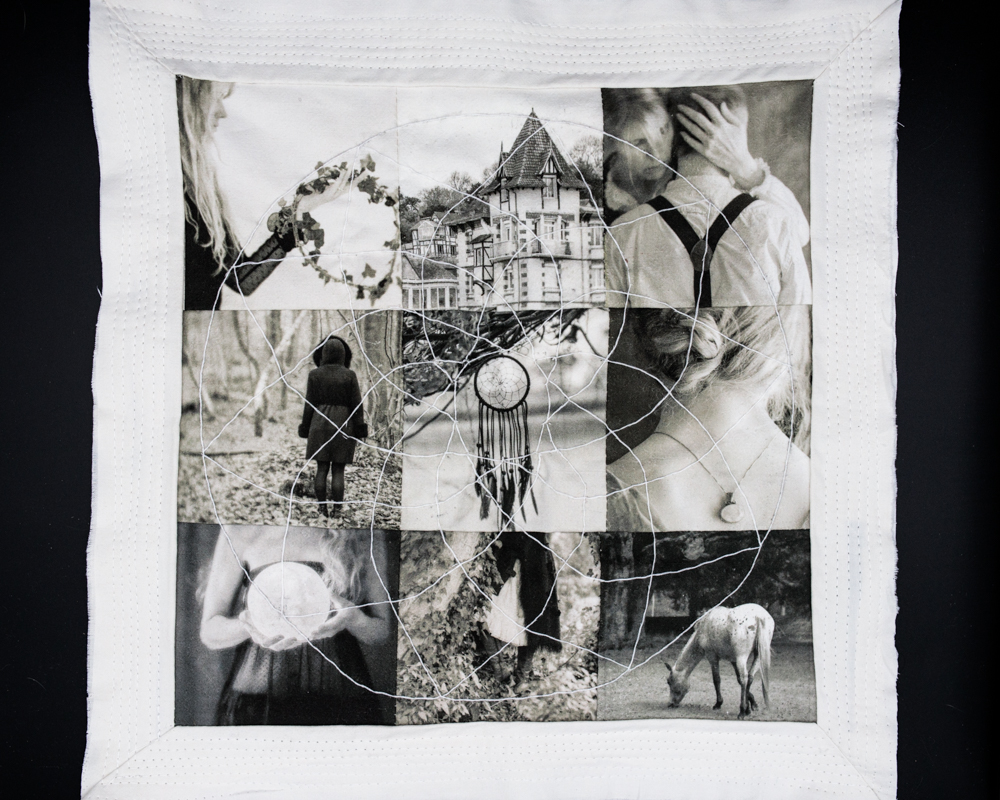
©Anne Renée Silver, Tapestry: Machine-and hand-stitched wall-hanging made from vintage linen. 24” x 24”

©Anne Renée Silver, Reclamation: Encaustic mixed media. One found and two original photos, a pressed sumac leaf, found papers, found objects, magnifying glass, jewelry box, pan pastels, mounted on a wooden puzzle box. 6” x 9”
Greg Banks is a photo-based artist and lecturer at Appalachian State University. He received his MFA in photography from East Carolina University in May 2017. He received a B.A. in photography and a B.A. in fine art from Virginia Intermont College in 1998. Greg combines everything from IPhone images to historic 19th century processes, gelatin silver printing, painting and digital printing. His current creative practice investigates family, folklore, memories, magic, history and religion in Appalachia.
Follow Greg Banks on Instagram: @gregbanksphoto
Posts on Lenscratch may not be reproduced without the permission of the Lenscratch staff and the photographer.
Recommended
-
Ragne Kristine Sigmond: Portraits of Painterly LightDecember 2nd, 2025
-
Mary Pat Reeve: Illuminating the NightDecember 1st, 2025
-
Ricardo Miguel Hernández: When the memory turns to dust and Beyond PainNovember 28th, 2025
-
Pamela Landau Connolly: Columbus DriveNovember 26th, 2025
-
MATERNAL LEGACIES: OUR MOTHERS OURSELVES EXHIBITIONNovember 20th, 2025


